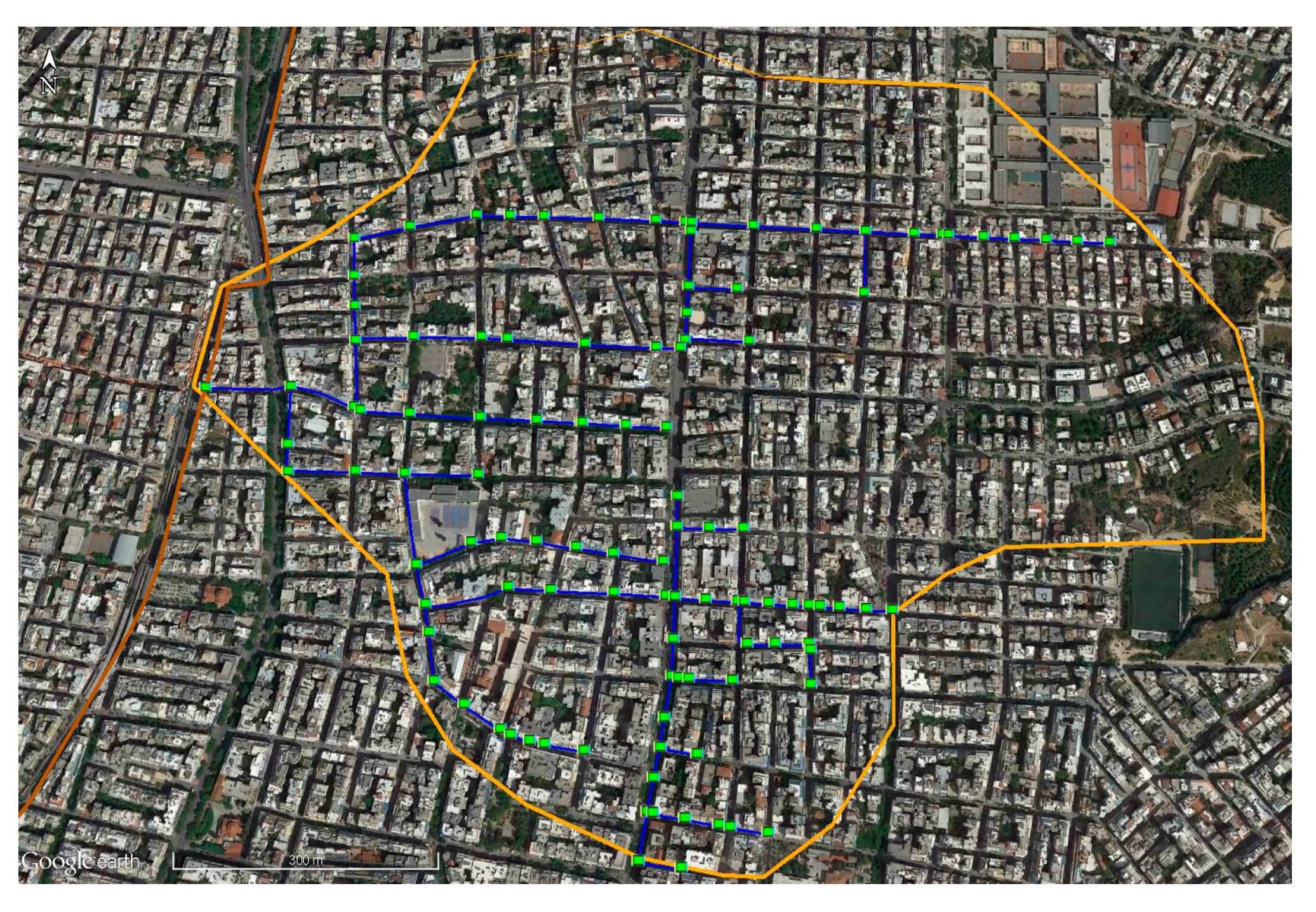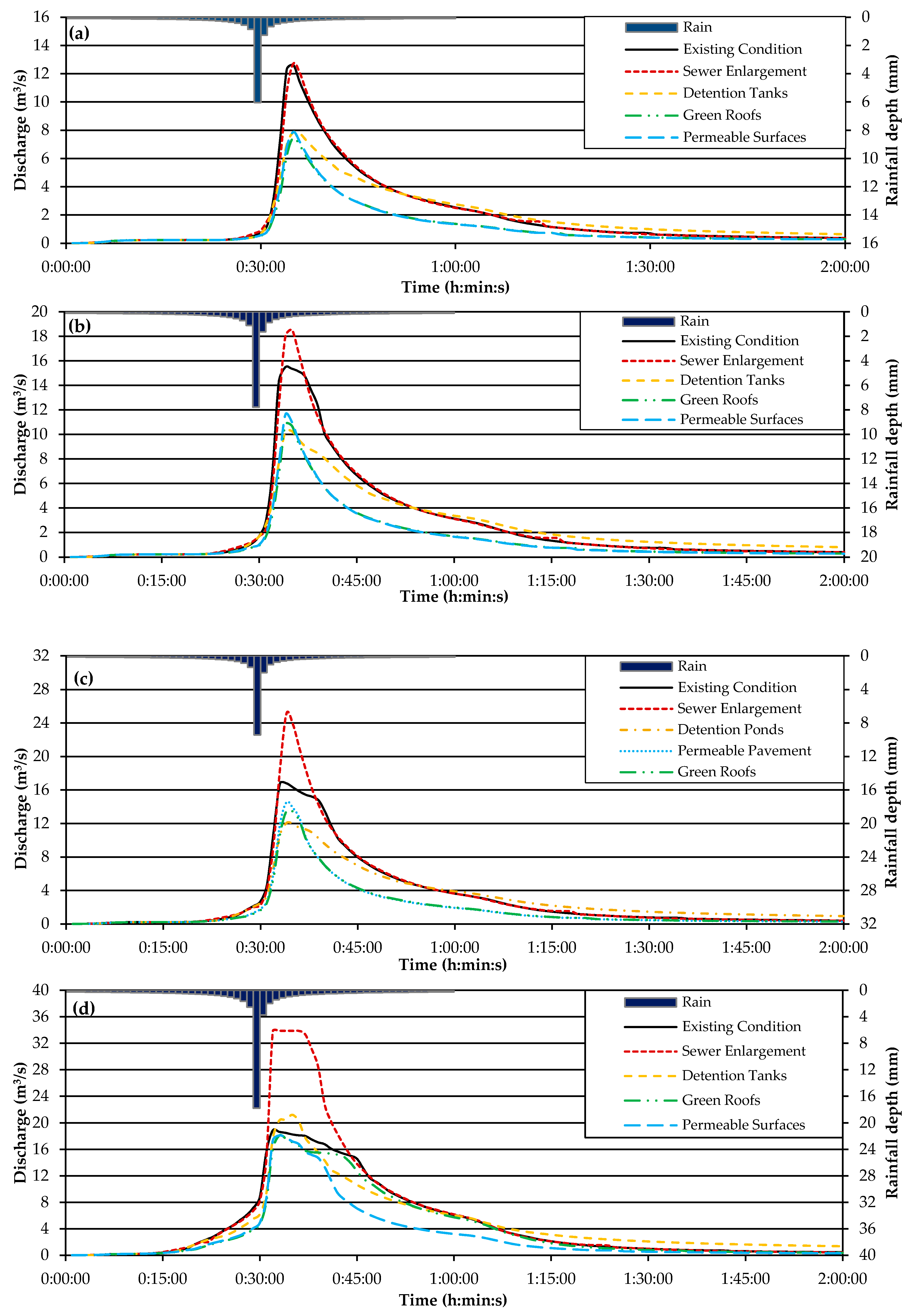Simulation of Low Impact Development (LID) Practices and Comparison with Conventional Drainage Solutions †
Abstract
:1. Introduction
2. Materials and Methods
2.1. Study Site
2.2. SWMM Model
2.3. LID Practices and Conventional Measures
3. Results and Discussion
4. Conclusions and Recommendations for Future Research
Author Contributions
Acknowledgments
Conflicts of Interest
References
- Larsen, T.A.; Gujer, W. The concept of sustainable urban water management. Water Sci. Technol. 1997, 35, 3–10. [Google Scholar] [CrossRef]
- Chocat, B.; Ashley, R.; Marsalek, J.; Matos, M.R.; Rauch, W.; Schilling, W.; Urbonas, B. Toward the sustainable management of urban storm-water. Indoor Built Environ. 2007, 16, 273–285. [Google Scholar] [CrossRef]
- Marlow, D.R.; Moglia, M.; Cook, S.; Beale, D.J. Towards sustainable urban water management: A critical reassessment. Water Res. 2013, 47, 7150–7161. [Google Scholar] [CrossRef]
- Wong, T.H.F.; Brown, R.R. The water sensitive city: Principles for practice. Water Sci. Technol. 2009, 60, 673–682. [Google Scholar] [CrossRef] [PubMed]
- Henonin, J.; Russo, B.; Mark, O.; Gourbesville, P. Real-time urban flood forecasting and modelling—A state of the art. J. Hydroinform. 2013, 15, 717–736. [Google Scholar] [CrossRef]
- Schmitt, T.G.; Thomas, M.; Ettrich, N. Analysis and modeling of flooding in urban drainage systems. J. Hydrol. 2004, 299, 300–311. [Google Scholar] [CrossRef]
- Chen, J.; Hill, A.A.; Urbano, L.D. A GIS-based model for urban flood inundation. J. Hydrol. 2009, 373, 184–192. [Google Scholar] [CrossRef]
- Salvadore, E.; Bronders, J.; Batelaan, O. Hydrological modelling of urbanized catchments: A review and future directions. J. Hydrol. 2015, 529, 62–81. [Google Scholar] [CrossRef]
- Krebs, P.; Larsen, T.A. Guiding the development of urban drainage systems by sustainability criteria. Water Sci. Technol. 1997, 35, 89–98. [Google Scholar] [CrossRef]
- Roy, A.H.; Wenger, S.J.; Fletcher, T.D.; Walsh, C.J.; Ladson, A.R.; Shuster, W.D.; Thurston, H.W.; Brown, R.R. Impediments and solutions to sustainable, watershed-scale urban stormwater management: Lessons from Australia and the United States. Environ. Manag. 2008, 42, 344–359. [Google Scholar] [CrossRef]
- Zevenbergen, C.; Veerbeek, W.; Gersonius, B.; Van Herk, S. Challenges in urban flood management: Travelling across spatial and temporal scales. J. Flood Risk Manag. 2008, 1, 81–88. [Google Scholar] [CrossRef]
- Damodaram, C.; Giacomoni, M.H.; Prakash Khedun, C.; Holmes, H.; Ryan, A.; Saour, W.; Zechman, E.M. Simulation of combined best management practices and low impact development for sustainable stormwater management. J. Am. Water Resour. Assoc. 2010, 46, 907–918. [Google Scholar] [CrossRef]
- Li, C.; Liu, M.; Hu, Y.; Han, R.; Shi, T.; Qu, X.; Wu, Y. Evaluating the hydrologic performance of low impact development scenarios in a micro urban catchment. Int. J. Environ. Res. Public Health 2018, 15, 273. [Google Scholar] [CrossRef] [PubMed]
- Kourtis, I.M.; Tsihrintzis, V.A. Economic Valuation of ecosystem services provided by the restoration of an irrigation canal to a riparian corridor. Environ. Process. 2017, 4, 749–769. [Google Scholar] [CrossRef]
- Burszta-Adamiak, E.; Mrowiec, M. Modelling of green roofs’ hydrologic performance using EPA’s SWMM. Water Sci. Technol. 2013, 68, 36–42. [Google Scholar] [CrossRef]
- Zhou, Q. A review of sustainable urban drainage systems considering the climate change and urbanization impacts. Water 2014, 6, 976–992. [Google Scholar] [CrossRef]
- Palla, A.; Gnecco, I. Hydrologic modeling of low impact development systems at the urban catchment scale. J. Hydrol. 2015, 528, 361–368. [Google Scholar] [CrossRef]
- Chui, T.F.M.; Liu, X.; Zhan, W. Assessing cost-effectiveness of specific LID practice designs in response to large storm events. J. Hydrol. 2016, 533, 353–364. [Google Scholar] [CrossRef]
- Chen, P.Y.; Tung, C.P.; Li, Y.H. Low impact development planning and adaptation decision-making under climate change for a community against pluvial flooding. Water 2017, 9, 756. [Google Scholar] [CrossRef]
- Giacomoni, M.H.; Joseph, J. Multi-objective evolutionary optimization and Monte Carlo simulation for placement of low impact development in the catchment scale. J. Water Res. Plan. Manag. 2017, 143, 04017053. [Google Scholar] [CrossRef]
- Wang, M.; Sun, Y.; Sweetapple, C. Optimization of storage tank locations in an urban stormwater drainage system using a two-stage approach. J. Environ. Manag. 2017, 204, 31–38. [Google Scholar] [CrossRef] [PubMed]
- Kourtis, I.M.; Tsihrintzis, V.A.; Baltas, E.A. Modelling of a combined sewer system and evaluation of mitigation measures using SWMM. Eur. Water 2017, 57, 12–128. [Google Scholar]
- Selvalingam, S.; Liong, S.Y.; Manoharan, P.C. Use of RORB and SWMM models to an urban catchment in Singapore. Adv. Water Resour. 1987, 10, 78–86. [Google Scholar] [CrossRef]
- Tsihrintzis, V.A.; Hamid, R.; Fuentes, H.R. Calibration and verification of watershed quality model SWMM in sub-tropical urban areas. In Proceedings of the First International Conference on Water Resources Engineering, ASCE, San Antonio, TX, USA, 14–18 August 1995; pp. 373–377. [Google Scholar]
- Tsihrintzis, V.A.; Hamid, R. Runoff quality prediction from small urban catchments using SWMM. Hydrol. Process. 1998, 12, 311–329. [Google Scholar] [CrossRef]
- Bellos, V.; Kourtis, I.M.; Moreno-Rodenas, A.; Tsihrintzis, V.A. Quantifying roughness coefficient uncertainty in urban flooding simulations through a simplified methodology. Water 2017, 9, 944. [Google Scholar] [CrossRef]
- Kourtis, I.M.; Kopsiaftis, G.; Bellos, V.; Tsihrintzis, V.A. Calibration and validation of SWWM model in two urban catchments in Athens, Greece. In Proceedings of the 15th International Conference on Environmental Science and Technology (CEST 2017), Rhodes, Greece, 31 August–2 September 2017; pp. 1–6. [Google Scholar]
- ASCE. Design and Construction of Urban Stormwater Management Systems; ASCE: New York, NY, USA, 1992. [Google Scholar]
- Chow, V.T. Open-Channel Hydraulics; McGraw-Hill Book Company, Inc.: New York, NY, USA, 1959. [Google Scholar]
- Rossman, L.A. Storm Water Management Model, User’s Manual, Version 5.0.; National Risk Management Research Laboratory, Office of Research and Development, US Environmental Protection Agency: Cincinnati, OH, USA, 2010; p. 276. [Google Scholar]
- Mimikou, M.; Baltas, E.; Varanou, E. A study of extreme storm events in Athens greater area. In Proceedings of the a Symposium, the Extreme of Extremes, Extraordinary Floods, Reykjavik, Iceland, 17–19 July 2000; IAHS Publ. No. 271. [Google Scholar]
- USBR (U.S. Bureau of Reclamation). Design of Arch Dams; U.S. Government Printing Office: Denver, CO, USA, 1977. [Google Scholar]
- Walsh, T.C.; Pomeroy, C.A.; Burian, S.J. Hydrologic modeling analysis of a passive, residential rainwater harvesting program in an urbanized, semi-arid watershed. J. Hydrol. 2014, 508, 240–253. [Google Scholar] [CrossRef]
- Guan, M.; Sillanpää, N.; Koivusalo, H. Assessment of LID practices for restoring pre-development runoff regime in an urbanized catchment in southern Finland. Water Sci. Technol. 2015, 71, 1485–1491. [Google Scholar] [CrossRef]
- Rosa, D.J.; Clausen, J.C.; Dietz, M.E. Calibration and verification of SWMM for low impact development. J. Am. Water Resour. Assoc. 2015, 51, 746–757. [Google Scholar] [CrossRef]
- Brunetti, G.; Šimůnek, J.; Piro, P. A comprehensive numerical analysis of the hydraulic behavior of a permeable pavement. J. Hydrol. 2016, 540, 1146–1161. [Google Scholar] [CrossRef]
- Rossman, L.; Huber, W. Storm Water Management Model Reference Manual: Volume III–Water Quality; US Environmental Protection Agency, Office of Research and Development, National Risk Management Laboratory: Cincinnati, OH, USA, 2016. [Google Scholar]
- Xie, J.; Wu, C.; Li, H.; Chen, G. Study on storm-water management of grassed swales and permeable pavement based on SWMM. Water 2017, 9, 840. [Google Scholar] [CrossRef]
- Zhang, S.; Guo, Y. SWMM simulation of the storm water volume control performance of permeable pavement systems. J. Hydrol. Eng. 2014, 20, 06014010. [Google Scholar] [CrossRef]
- Qin, H.P.; Li, Z.X.; Fu, G. The effects of low impact development on urban flooding under different rainfall characteristics. J. Environ. Manag. 2013, 129, 577–585. [Google Scholar] [CrossRef] [PubMed]


| Parameter | Units | Range | Parameter | Units | Range |
|---|---|---|---|---|---|
| (1) Area | ha | 0.02–6.68 | (6) Dstore-Imperv | mm | 2.54 |
| (2) Width | m | 7.93–162.77 | (7) Dstore-Perv | mm | 6.51 |
| (3) %Imperv | % | 45–90 | (8) CN | - | 77–94 |
| (4) N-Imperv | s/m1/3 | 0.015 | (9) Manning | s/m1/3 | 0.013–0.014 |
| (5) N-Perv | s/m1/3 | 0.2 | (10) Time step | s | 0.1 |
| Layer | Parameter | Green Roof | Permeable Pavement | Description |
|---|---|---|---|---|
| Surface | Berm height (mm) | 100 | 0 | Maximum depth to which water can pond. |
| Vegetation volume fraction | 0.2 | 0 | Fraction of the volume within the surface storage depth filled with vegetation. | |
| Surface roughness (s/m1/3) | 0.25 | 0.015 | Manning’s coefficient for overland flow. | |
| Surface slope (%) | 1 | 1 | Roof surface slope. | |
| Soil | Thickness (mm) | 200 | - | Soil layer thickness. |
| Porosity (volume fraction) | 0.5 | - | Volume of pore space relative to total volume of soil. | |
| Field capacity (volume fraction) | 0.4 | - | Volume of pore water relative to total volume after the soil is fully drained. | |
| Wilting point (volume fraction) | 0.1 | - | Volume of pore water relative to total volume in fully dried soil where only bound water remains. | |
| Conductivity (mm/h) | 1000 | - | Hydraulic conductivity for fully saturated soil. | |
| Conductivity slope | 10 | - | Slope of the curve of log (conductivity) versus soil moisture content. | |
| Suction head (mm) | 50 | - | Average value of soil capillary suction along the wetting front. | |
| Pavement | Thickness (mm) | - | 150 | Pavement layer thickness. |
| Void ratio (Void/Solids) | - | 0.15 | Volume of void space relative to the volume of solids in the pavement. | |
| Permeability (mm/h) | - | 500 | Permeability of the concrete or asphalt. | |
| Drainage mat | Thickness (mm) | 100 | - | Thickness of the mat or plate. |
| Void fraction | 0.3 | - | Ratio of void volume to total volume. | |
| Roughness (m/s1/3) | 0.015 | - | Manning’s coefficient. | |
| Storage | Thickness (mm) | - | 400 | Thickness of gravel layer. |
| Void ratio (Void/Solids) | - | 0.3 | Volume of void space relative to the volume of solids in layer. | |
| Seepage fate (mm/h) | - | 750 | Rate at which water seeps into the native soil below the layer. |
Publisher’s Note: MDPI stays neutral with regard to jurisdictional claims in published maps and institutional affiliations. |
© 2018 by the authors. Licensee MDPI, Basel, Switzerland. This article is an open access article distributed under the terms and conditions of the Creative Commons Attribution (CC BY) license (https://creativecommons.org/licenses/by/4.0/).
Share and Cite
Kourtis, I.M.; Tsihrintzis, V.A.; Baltas, E. Simulation of Low Impact Development (LID) Practices and Comparison with Conventional Drainage Solutions. Proceedings 2018, 2, 640. https://doi.org/10.3390/proceedings2110640
Kourtis IM, Tsihrintzis VA, Baltas E. Simulation of Low Impact Development (LID) Practices and Comparison with Conventional Drainage Solutions. Proceedings. 2018; 2(11):640. https://doi.org/10.3390/proceedings2110640
Chicago/Turabian StyleKourtis, Ioannis M., Vassilios A. Tsihrintzis, and Evangelos Baltas. 2018. "Simulation of Low Impact Development (LID) Practices and Comparison with Conventional Drainage Solutions" Proceedings 2, no. 11: 640. https://doi.org/10.3390/proceedings2110640
APA StyleKourtis, I. M., Tsihrintzis, V. A., & Baltas, E. (2018). Simulation of Low Impact Development (LID) Practices and Comparison with Conventional Drainage Solutions. Proceedings, 2(11), 640. https://doi.org/10.3390/proceedings2110640




